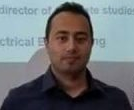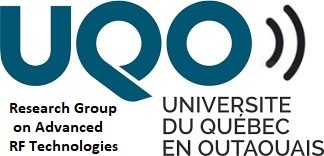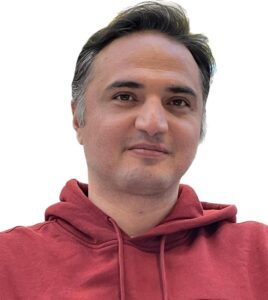Our team

Prof. Halim Boutayeb received the Diplôme d’Ingénieur (B.Sc.) degree in electrical engineering from the École Supérieur d’Ingénieur de Rennes, France, in 2000, and the French D.E.A. (M.Sc.) degree and Ph.D. degree in electrical engineering from the University of Rennes, France, in 2000 and 2003, respectively. From March 2004 to December 2006, he was with INRS-EMT, Montréal, QC, Canada. From Jan. 2007 to Dec, 2011, he was a Researcher with the École Polytechnique de Montréal, Montréal, QC, Canada. He was also Coordinator and a member of the Centre de Recherche en Électronique Radiofréquence (CREER), a strategic cluster on applied electromagnetics and RF technologies. From Jan. 2012 to June 2020, he was a Research and Development Staff Member with the Huawei Technologies Company Ltd., Ottawa, ON, Canada. Since July 2020, He has been a Professor in Electrical Engineering at Université du Québec en Outaouais, Gatineau, Canada.
He has authored or coauthored more than 100 journal and conference papers, and he holds 24 patents. Since 2003, he has been a Reviewer for a number of scientific journals and conferences. His main fields of interest are antennas, microwaves circuits, the finite-difference time-domain (FDTD) method, artificial materials, radars, local positioning systems, biomedical engineering, and phased arrays.
Dr. Boutayeb is a Senior Member of the Professional Engineers of Quebec. He has served as a Technical Program Committee member of the IEEE Vehicular Technology Conference (VTC) 2006 and as a Steering Committee member of the IEEE Microwave Theory and Techniques Society (IEEE MTT-S) International Microwave Symposium (IMS) 2012. He was a recipient of the Natural Sciences and Engineering Research Council of Canada (NSERC) Postdoctoral Fellowship Grant (2004–2006), the Best Paper Award of the European Conference on Antennas and Propagation (2004), and five Gold Huawei Medal Awards (2013, 2015, 2017, 2018 and 2019).

He designed antennas for satellite and ground systems, including shaped reflectors for contoured beam coverage for satellite earth observation, wide scan very small aperture terminal (VSAT) reflector antenna for multi-satellite Space-Way program. He built and tested various antennas at different frquency bands for wideband, dual-band, single horns, coaxial horns for feeding single and dual reflector antennas. He designed di-chroic surfaces at S and Ku bands, and prepared studies on reflector antennas for space based radar communications. He worked on high frequency electromagnetic ray techniques for the prediction of radar cross-section and on field computations for electromagnetic compatibility (EMC) and electromagnetic interference (EMI) applications.
He also worked on new product development of array antennas in 824 – 960MHz, 2.1 – 2.7 GHz and 5.25 – 5.875 GHz band, on dual slant GSM and UMTS bisector antenna arrays (BSA), vertically and horizontally polarized (HP) sector beam with variable electrical tilt (VET) and HP omni-directional linear arrays, and on the design of dual band dual polarized antenna, and low insertion loss wide band variable phase shifters in air line and printed circuit board (PCB) technologies for variable electrical tilt (VET) base station antennas.
He is presently working on a new range of electrically steered, high performance antennas for 3G and WiMax networks, designing and manufacturing compact dual wide band dual linearly polarized, circularly polarized (CP) and polarization diversity radiators for wireless and Radio Frequency Identification applications. He is designing novel antennas for wireless and mobile communications using a hybrid structure of metal and printed circuit boards.
He has passion for solving EMI and EMC issues in packaging antennas for wireless applications.
Specialties: Electromagnetics, antennas, RF and microwave engineering with skills in computer aided enginreering design tools such as HFSS, CST, TICRA, WIPL-D, IE3D, and Microwave Studio
 Dr.Bilel Mnasri received the Ph.D. degree in Electrical Engineering from the University of Montreal (Ecole Polytechnique), Montreal, QC, CANADA, in 2019. He is currently a Mitacs Accelerate postdoctoral fellow with Huawei Ottawa R&D Centre and UQO. He has authored several peer-reviewed journal and conference papers and holds one U.S. patent. His current research interests include wireless communications, experimental radio channel characterization, signal processing, MIMO systems, and microwave/millimeter-wave components and transceiver design for 5G systems and beyond.
Dr.Bilel Mnasri received the Ph.D. degree in Electrical Engineering from the University of Montreal (Ecole Polytechnique), Montreal, QC, CANADA, in 2019. He is currently a Mitacs Accelerate postdoctoral fellow with Huawei Ottawa R&D Centre and UQO. He has authored several peer-reviewed journal and conference papers and holds one U.S. patent. His current research interests include wireless communications, experimental radio channel characterization, signal processing, MIMO systems, and microwave/millimeter-wave components and transceiver design for 5G systems and beyond.

Between 2018 and 2021, he was a research assistant in the department of electrical and computer engineering. He iscurrentlypursuing a Ph.D. degreewith the Département d’informatique et d’ingénierie Université du Québec en Outaouais (UQO), Gatineau, Quebec, Canada. Professor Halim Boutayeb is the supervisor of his doctoral thesis. He has a wide range of interests including satellite antennas, mono-pulse radar systems, mm-wave and microwave antennas, multifunctionalelectronic devices, multilayer PCB-based antennas, helical antennas, beamforming networks, slot array antennas, decoupling networks, diplexers, and substrate integrated waveguides.

She worked on Computational Imaging and Frequency Diversity Antenna based on Metasurface Structures as her Master thesis. She has strong background in Antenna RF Designing with a demonstrated history of working in the higher education industry. She has lots of experience in designing antenna, microstrip filters, passive microwave components, microwave transmitters and receivers. She is currently pursuing the Ph.D. degree at Universite du Quebec en Outaouais (UQO) under supervision of professor Halim Boutayeb. Her research interests include advanced agile antennas, Applied electromagnetic, Metamaterial and MetasurfaceAntenna, RF systems, Frequency diverse imaging systems, Microwave, millimeter and submillimeter wave Active and Passive Components, Microwave-Photonic Devices.
 Mohammad Marvasti received his BSc Diploma in Electrical Engineering major at the AmirKabir University of Technology, Tehran, Iran, in 2015. During his BSc period, he received the 1st rank among all of his entrance colleagues. Therefore, he was awarded direct admission to MSc of the Sharif University of Technology, Tehran, 1st ranked university in Iran. He received his MSc degree in Telecommunications focusing on applied electromagnetics from Sharif in 2017.
He has authored three papers in well-known journals. He experienced teaching assistant in “Fields and Waves” and “Electrical Engineering Lab” courses.
From 2017 until 2022, he was working on designing, fabricating, and testing antenna systems and passive radio-frequency components in 3, 4, 5, 6, and 24GHz frequency bands in a highly result-oriented company, Pionaria in Tehran, Iran. The main focus of his works was designing high-gain dual-polarization splash-plate feed parabolic antennas.
He has started his Ph.D. research on developing novel ideas to achieve capacity growth of 5G and beyond mobile networks at Université du Québec en Outaouais, Gatineau, Canada, from 2022. He is intended to work on the novel subject of the Orbital Angular Momentum antenna systems.
Mohammad Marvasti received his BSc Diploma in Electrical Engineering major at the AmirKabir University of Technology, Tehran, Iran, in 2015. During his BSc period, he received the 1st rank among all of his entrance colleagues. Therefore, he was awarded direct admission to MSc of the Sharif University of Technology, Tehran, 1st ranked university in Iran. He received his MSc degree in Telecommunications focusing on applied electromagnetics from Sharif in 2017.
He has authored three papers in well-known journals. He experienced teaching assistant in “Fields and Waves” and “Electrical Engineering Lab” courses.
From 2017 until 2022, he was working on designing, fabricating, and testing antenna systems and passive radio-frequency components in 3, 4, 5, 6, and 24GHz frequency bands in a highly result-oriented company, Pionaria in Tehran, Iran. The main focus of his works was designing high-gain dual-polarization splash-plate feed parabolic antennas.
He has started his Ph.D. research on developing novel ideas to achieve capacity growth of 5G and beyond mobile networks at Université du Québec en Outaouais, Gatineau, Canada, from 2022. He is intended to work on the novel subject of the Orbital Angular Momentum antenna systems.
Meghdad Khodaei received his BSc degree in Electrical Engineering from Zanjan University, Zanjan, Iran, in 2009, and the MSc degree in Electrical and Telecommunications Engineering from Shahid Beheshti University, Tehran, Iran, in 2012.
He developed an orthogonal synthesis method for beamforming phase array antennas during his master’s degree. From 2012 to 2022, he worked as an RF engineer and designed and developed active and passive RF components as well as transceiver modules for communication systems. Currently, he is a PhD student at the University du Quebec in Outaouais (UQO), Gatineau, Canadaundersupervision of professor Halim Boutayeb. His research interests include Wireless communication systems, satellite communication, periodic structure and metasurface antenna, Phase array antenna, RF energy harvesting, Power amplifier design, Microwave measurement, Multilayer PCB design and Electrical Protection Circuits for T/R modules.



